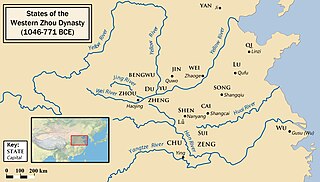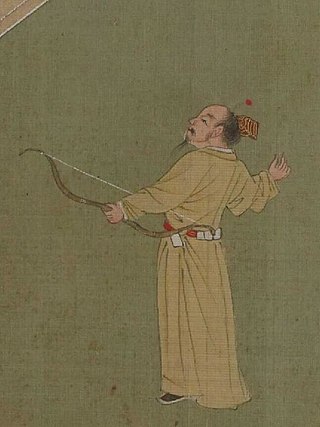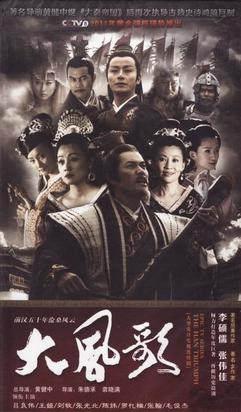
The Shang dynasty, also known as the Yin dynasty, was a Chinese royal dynasty founded by Tang of Shang that ruled in the Yellow River valley in the second millennium BC, traditionally succeeding the Xia dynasty and followed by the Western Zhou dynasty. The classic account of the Shang comes from texts such as the Book of Documents, Bamboo Annals and Records of the Grand Historian. Modern scholarship dates the dynasty between the 16th to 11th centuries BC, with more agreement surrounding the end date than beginning date.

The Xia dynasty is the first dynasty in traditional Chinese historiography. According to tradition, the Xia dynasty was established by the legendary Yu the Great, after Shun, the last of the Five Emperors, gave the throne to him. In traditional historiography, the Xia was later succeeded by the Shang dynasty.

The Western Zhou was a period of Chinese history, approximately first half of the Zhou dynasty, before the period of the Eastern Zhou. It began when King Wu of Zhou overthrew the Shang dynasty at the Battle of Muye and ended when Quanrong pastoralists sacked its capital Haojing and killed King You of Zhou in 771 BC.

Wu Ding ; personal name Zi Zhao (子昭), was a king of the Shang dynasty who ruled China around the second half of the 1200s BC. He is the earliest figure in Chinese history mentioned in contemporary records. The annals of the Shang dynasty compiled by later historians were once thought to be little more than legends until oracle script inscriptions on bones dating from his reign were unearthed at the ruins of his capital Yin in 1899. Oracle bone inscriptions from his reign have been radiocarbon dated to 1254–1197 BC ±10 years, closely according with regnal dates derived by modern scholars from received texts, epigraphic evidence, and astronomical calculations.

The Battle of Muye, Mu, or Muh was a battle fought in ancient China between the rebel Zhou state and the reigning Shang dynasty. The Zhou army, led by Wu of Zhou, defeated the defending army of king Di Xin of Shang at Muye and captured the Shang capital Yin, ending the Shang dynasty. The Zhou victory led to the establishment of the Zhou dynasty, and is used in Chinese historiography as a justified example of the doctrine of the Mandate of Heaven.
The Xia–Shang–Zhou Chronology Project was a multi-disciplinary project commissioned by the People's Republic of China in 1996 to determine with accuracy the location and time frame of the Xia, Shang, and Zhou dynasties.

Song was a state during the Zhou dynasty of ancient China, with its capital at Shangqiu. The state was founded soon after King Wu of Zhou conquered the Shang dynasty to establish the Zhou dynasty in 1046 BC. It was conquered by the State of Qi in 286 BC, during the Warring States period. Confucius is traditionally considered to have been a descendant of a Song nobleman who moved to the State of Lu.
Tai Geng or Da Geng, personal name Zi Bian (子辨), was a king of the Shang dynasty of ancient China.
Zu Yi, personal name Zǐ Téng, was a Shang dynasty King of China.
Zu Ding, personal name Zi Xin, was a king of the Chinese Shang dynasty.

Wu Yi (武乙), personal name Zi Qu (子瞿) was king of the Shang dynasty of ancient China from 1147 to 1112 BC. According to the Bamboo Annals, his capital was at Yin. He was a son of his predecessor Geng Ding and father of King Wen Ding.

Ancient Chinese coinage includes some of the earliest known coins. These coins, used as early as the Spring and Autumn period (770–476 BCE), took the form of imitations of the cowrie shells that were used in ceremonial exchanges. The same period also saw the introduction of the first metal coins; however, they were not initially round, instead being either knife shaped or spade shaped. Round metal coins with a round, and then later square hole in the center were first introduced around 350 BCE. The beginning of the Qin dynasty (221–206 BCE), the first dynasty to unify China, saw the introduction of a standardised coinage for the whole Empire. Subsequent dynasties produced variations on these round coins throughout the imperial period. At first the distribution of the coinage was limited to use around the capital city district, but by the beginning of the Han dynasty, coins were widely used for such things as paying taxes, salaries and fines.

Sets and individual examples of ritual bronzes survive from when they were made mainly during the Chinese Bronze Age. Ritual bronzes create quite an impression both due to their sophistication of design and manufacturing process, but also because of their remarkable durability. From around 1650 BCE, these elaborately decorated vessels were deposited as grave goods in the tombs of royalty and the nobility, and were evidently produced in very large numbers, with documented excavations finding over 200 pieces in a single royal tomb. They were produced for an individual or social group to use in making ritual offerings of food and drink to his or their ancestors and other deities or spirits. Such ceremonies generally took place in family temples or ceremonial halls over tombs. These ceremonies can be seen as ritual banquets in which both living and dead members of a family were supposed to participate. Details of these ritual ceremonies are preserved through early literary records. On the death of the owner of a ritual bronze, it would often be placed in his tomb, so that he could continue to pay his respects in the afterlife; other examples were cast specifically as grave goods. Indeed, many surviving examples have been excavated from graves.

Three Kingdoms is a 2010 Chinese television series based on the events in the late Eastern Han dynasty and the Three Kingdoms period. The plot is adapted from the 14th century historical novel Romance of the Three Kingdoms and other stories about the Three Kingdoms period. Directed by Gao Xixi, the series had a budget of over 160 million RMB and took five years of pre-production work. Shooting of the series commenced in October 2008, and it was released in China in May 2010.
Guifang was an ancient ethnonym for a northern people that fought against the Shang Dynasty. Chinese historical tradition identified the Guifang with the Rong, Di, Xunyu, Xianyun, or Xiongnu peoples. This Chinese exonym combines gui and fang, a suffix referring to "non-Shang or enemy countries that existed in and beyond the borders of the Shang polity."
The State of Quán was a small Zhou Dynasty vassal state of Central China. A Marquisate, then Dukedom (侯), its rulers were descendants of Shang Dynasty ruler Wu Ding with the surname Zi (子). Quan was founded by Wen Ding’s son Quan Wending (权文丁) in the area of modern day Maliang Town (马良镇), Shayang County, Jingmen City, Hubei Province, next to what would later emerge as the State of Chu.
Pi was a Zhou dynasty vassal state in ancient China. Also known as Xue, Pi was ruled by members of the Ren (任) family.

The Han Triumph, also known as Wind Ode, is a Chinese television series based on historical events in the early Han dynasty, beginning with the founding of the dynasty by Liu Bang after his triumph over Xiang Yu, and the events leading to the reign of Liu Heng. Directed by Huang Jianzhong, the series starred Ray Lui, Wang Ji, Liu Mu, Zhang Guangbei, Chen Wei and Li Qingxiang in the leading roles. It was first broadcast on CCTV-8 in China on 17 December 2011.

The Advisors Alliance is a 2017 Chinese two-part television series based on the life of Sima Yi, a government official and military general who lived in the late Eastern Han dynasty and Three Kingdoms period of China. The series starred Wu Xiubo as the main character, with Liu Tao, Li Chen, Janine Chang, Tang Yixin, Yu Hewei and Wang Luoyong playing supporting roles. The first part of the series started airing on Jiangsu TV and Anhui TV on 22 June 2017. The second part started airing on Youku on 8 December 2017.











